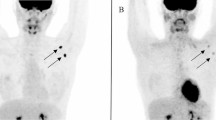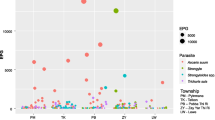Abstract
Blastocystis is an enteric protozoan parasite commonly found in humans and animals. Phylogenetic and genotypic analyses have shown that Blastocystis exhibits extreme genetic diversity, and humans are host to a number of zoonotic isolates. In the present study, the prevalence of Blastocystis in 276 stool samples from a hospital in Singapore was examined, and for the first time, riboprinting using polymerase chain reaction-restriction fragment length polymorphism (PCR-RFLP) was used to determine the genetic diversity of the Blastocystis isolated from the Singapore population. The prevalence rate was determined to be 3.3% (9/276), and Blastocystis displaying two main ribotypes were isolated. As a comparison, we performed PCR-RFLP using two different published methodologies, and both methods allowed the isolates to be divided into two distinct groups based on their riboprint patterns. According to a recently proposed classification scheme, 78% (7/9) of the isolates were of subtype 3, while 22% (2/9) were subtype 1. The predominance of subtype 3 in an urbanized city state such as Singapore is in agreement with the idea that subtype 3 is a genotype of human origin.



Similar content being viewed by others

References
Abe N, Wu Z, Yoshikawa H (2003a) Molecular characterization of Blastocystis isolates from birds by PCR with diagnostic primers and restriction fragment length polymorphism analysis of small subunit ribosomal RNA gene. Parasitol Res 89:393–396
Abe N, Wu Z, Yoshikawa H (2003b) Zoonotic genotypes of Blastocystis detected in cattle and pigs by PCR with diagnostic primers and restriction fragment length polymorphism analysis of small subunit ribosomal RNA gene. Parasitol Res 90:124–128
Abe N, Wu Z, Yoshikawa H (2003c) Molecular characterization of Blastocystis isolates from primates. Vet Parasitol 113:321–325
Amin OM (2002) Seasonal prevalence of intestinal parasites in the United States during 2000. Am. J Trop Med Hyg 66(6):799–803
Andiran N, Acikgoz ZC, Turkay S, Andiran F (2006) Blastocystis hominis—an emerging and imitating cause of acute abdomen in children. J Pediatr Surg 41:1489–1491
Böhm-Gloning B, Knobloch J, Walderich B (1997) Five subgroups of Blastocystis from symptomatic and asymptomatic patients revealed by restriction site analysis of PCR-amplified 16S-like rDNA. Trop Med Int Health 2(8):771–778
Carrascosa M, Martinez J, Perez-Castrillon JL (1996) Hemorrhagic proctosigmoiditis and Blastocystis hominis infection. Ann Intern Med 124:9
Chen TL, Chan CC, Chen HP, Fung CP, Lin CP, Chan WL, Liu CY (2003) Clinical characteristics and endoscopic findings associated with Blastocystis hominis in healthy adults. Am. J Trop Med Hyg 69:213–216
Clark CG (1992) Riboprinting: a molecular approach to the identification and taxonomy of protozoa. In: Lee JJ, Soldo AT (eds) Protocol in protozoology. Allen, Lawrence, Kansas, pp D–4.1–D-4.4
Clark CG (1997) Extensive genetic diversity in Blastocystis. Mol Biochem Parasitol 87:79–83
Ho LC, Jeyaseelan K, Singh M (2001) Use of the elongation factor-1α gene in a polymerase chain reaction-based restriction-fragment-length polymorphism analysis of genetic heterogeneity among Blastocystis species. Mol Biochem Parasitol 112:287–291
Horiki N, Maruyama M, Fujita Y, Yonekura T, Minato S, Kaneda Y (1997) Epidemiological survey of Blastocystis infection in Japan. Am J Trop Med Hyg 56(4):370–374
Jones WR (1946) The experimental infection of rats with Entamoeba histolytica; with a method for evaluating the anti-amoebic properties of new compounds. Ann Trop Med Parasitol 40:130–140
Kaneda Y, Horiki N, Cheng XJ, Fujita Y, Maruyama M, Tachibana H (2001) Ribodemes of Blastocystis isolated in Japan. Am J Trop Med Hyg 65:393–396
Leder K, Hellard ME, Sinclair MI, Fairley CK, Wolfe R (2005) No correlation between clinical symptoms and Blastocystis hominis in immunocompetent individuals. J Gastroenterol Hepatol 20:1390–1394
Levy Y, Georger J, Shoenfeld Y (1996) Severe Blastocystis hominis in an elderly man. J Infect 33:57–59
Leelayoova S, Rangsin R, Taamasri P, Naaglor T, Thathaisong U, Mungthin M (2004) Evidence of waterborne transmission of Blastocystis hominis. Am J Trop Med Hyg 70:658–662
Menon BS, Abdullah MS, Mahamud F, Singh B (1999) Intestinal parasites in Malaysian children with cancer. J Trop Pediatr 45(4):241–242
Noël C, Dufernez F, Gerbod D, Edgcomb VP, Delgado-Viscogliosi P, Ho LC, Singh M, Wintjens R, Sogin ML, Capron M, Pierce R, Zenner L, Viscogliosi E (2005) Molecular phylogenies of Blastocystis isolates from different hosts: implications for genetic diversity, identification of species, and zoonosis. J Clin Microbiol 43(1):348–355
Quílez J, Clavel A, Sánchez Acedo C, Causapé AC (1995a) Detection of Blastocystis sp. In pigs in Aragon (Spain). Vet Parasitol 56:345–348
Quílez J, Sánchez Acedo C, Clavel A, Causapé AC (1995b) Occurrence of Blastocystis sp. in cattle in Aragon, north-eastern Spain. Parasitol Res 81:703–705
Rivera WL, Tan MAV (2005) Molecular characterization of Blastocystis isolates in the Philippines by riboprinting. Parasitol Res 96:253–257
Simadibrata M, Tytgat GN, Yuwono V, Daldiyono, Lesmana LA, Syam AF, Ariawan I, Rani A (2004) Microorganisms and parasites in chronic infective diarrhea. Acta Med Indones 36(4):211–214
Sinniah B, Rajeswari B (1994) Blastocystis infection, a cause of human diarrhea. Southeast Asian J Trop Med Public Health 25(3):490–493
Stensvold CR, Suresh GK, Tan KSW, Thompson RCA, Traub RJ, Viscogliosi E, Yoshikawa H, Clark CG (2007) Terminology for Blastocystis subtypes—a consensus. Trends Parasitol 23(3):93–96
Stenzel DJ, Boreham PFL (1996) Blastocystis revisited. Clin Microbiol Rev 9:563–584
Svenungsson B, Lagergren A, Ekwall E, Evengard B, Hedlund KO, Karnell A, Lofdahl S, Svensson L, Weintraub A (2000) Enteropathogens in adult patients with diarrhea and healthy control subjects: a 1-year prospective study in a Swedish clinic for infectious diseases. Clin Infect Dis 30(5):770–778
Tan KSW (2004) Blastocystis in humans and animals: new insights using modern methodologies. Vet Parasitol 126:121–144
Thathaisong U, Worapong J, Mungthin M, Tan-Ariya P, Viputtigul K, Sudatis A, Noonai A, Leelayoova S (2003) Blastocystis isolates from a pig and a horse are closely related to Blastocystis. J Clin Microbiol l41(3):967–975
Teow WL, Ng GC, Chan PP, Chan YC, Yap EH, Zaman V, Singh M (1992) A survey of Blastocystis in reptiles. Parastiol Res 78:453–455
Tungtrongchitr A, Manatsathit S, Kositchaiwat C, Ongrotchanakun J, Munkong N, Chinabutr P, Leelakusolvong S, Chaicumpa W (2004) Blastocystis hominis infection in irritable bowel syndrome patients. Southeast Asian J Trop Med Public Health 35:705–710
Windsor JJ, Macfarlane L, Hughes-Thapa G, Jones SK, Whiteside TM (2002) Incidence of Blastocystis in faecal samples submitted for routine microbiological analysis. Br J Biomed Sci 59(3):154–157
Yoshikawa H, Nagano I, Yap EH, Singh M, Takahashi Y (1996) DNA polymorphism revealed by arbitrary primers polymerase chain reaction among Blastocystis strains isolated from humans, a chicken, and a reptile. J Euk Microbiol 43:127–130
Yoshikawa H, Nagano I, Wu Z, Yap EH, Singh M, Takahashi Y (1998) Genomic polymorphism among Blastocystis strains and development of subtype-specific diagnostic primers. Mol Cell Probes 12:153–159
Yoshikawa H, Abe N, Iwasawa M, Kitano S, Nagano I, Wu Z, Takahashi Y (2000) Genomic analysis of Blastocystis strains isolated from two long-term health care facilities. J Clin Microbiol 30(4):1324–1330
Yoshikawa H, Wu Z, Kimata I, Iseki M, Ali IK, Hossain MB, Zaman V, Haque R, Takahashi Y (2004) Polymerase chain reaction-based genotype classification among human Blastocystis hominis populations isolated from different countries. Parasitol Res 92:22–29
Zaman V, Ng GC, Suresh K, Yap EH, Singh M (1993) Isolation of Blastocystis from the cockroach (Dictyoptera Blattidae). Parasitol Res 79:73–74
Acknowledgements:
This work was generously supported by a grant from the Medical Research Council (NMRC/1071/2006). We are grateful to all the staff of the Microbiology Division of the Department of Laboratory Medicine, NUH for their help and advice in procuring the samples. We are also grateful to Mr Elden Kua and Ms Kang Kim Lian for their help during the early stages of this project. The experiments conducted were carried out in compliance with the laws and regulations of Singapore.
Author information
Authors and Affiliations
Corresponding author
Rights and permissions
About this article
Cite this article
Wong, K.H.S., Ng, G.C., Lin, R.T.P. et al. Predominance of subtype 3 among Blastocystis isolates from a major hospital in Singapore. Parasitol Res 102, 663–670 (2008). https://doi.org/10.1007/s00436-007-0808-0
Received:
Accepted:
Published:
Issue Date:
DOI: https://doi.org/10.1007/s00436-007-0808-0



